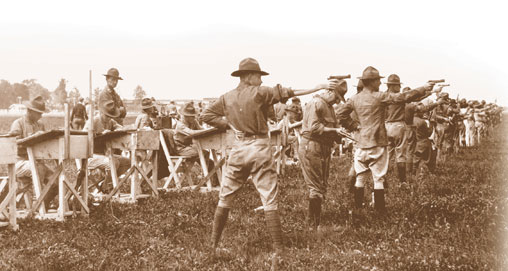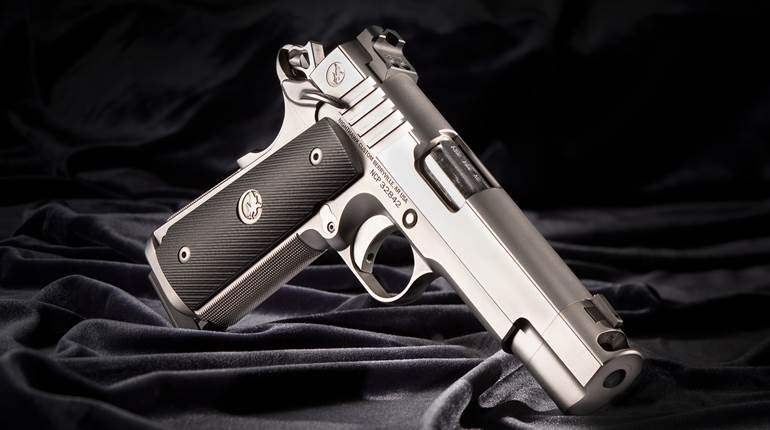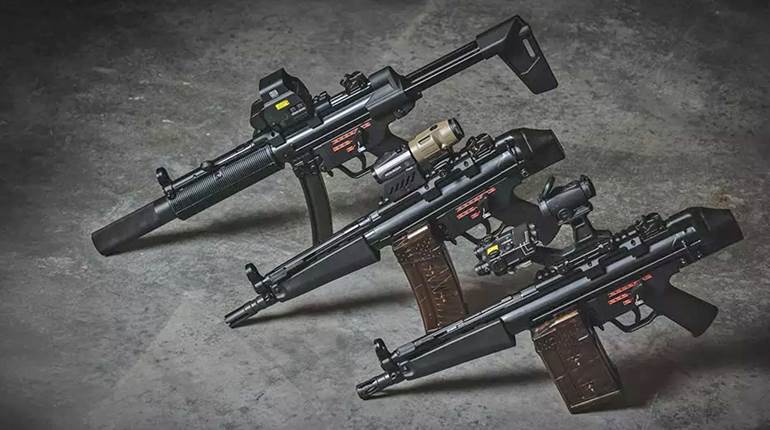
The development of the Model of 1911 began with the U.S. Army’s quest for an effective, reliable “automatic” pistol replacement for the cavalryman’s revolver. After a brief examination by an Army board of the Bergmann, Borchardt, Mannlicher and Mauser pistols, accompanied by the first Colt prototype automatic pistol, a more comprehensive evaluation of the Colt, Mannlicher and Mauser pistols was performed in 1899. The Colt created a very favorable impression; the others seemed clumsy, awkward and chambered for inadequate cartridges.
Coincident with the Army’s investigations into semi-automatic pistols was the beginning of the Philippine Insurrection at the end of the Spanish-American War, in which the .38 Colt-chambered revolvers then in service were found to be deficient in stopping power. For this and all later evaluations of pistol candidates, a caliber greater than .41 was to become a prime requirement.
However, rather than wait for pistol designers and manufacturers to create the “perfect” handgun, the Army continued to explore the use of semi-automatic pistols. Beginning in 1900, the Army began to acquire test quantities of commercial pistols for field testing and evaluation. A thousand Lugers in 7.65 mm and 475 Colt “Model 1900” pistols were acquired and issued to the U.S. Cavalry for field testing, while the Navy, not to be outdone, ordered 250 Colts. The results of these field trials were to shape the outline of the pistol that was to become the Model of 1911 and to establish the Colt/Browning design as the front-runner.
At each step along the way from 1898 to 1911, the posture taken by Colt appears to have been that whatever the Army wanted, the Army was going to get. Not only did Colt demonstrate that attitude, but John M. Browning also seems to have thought along those lines. As deficiencies were identified, whether by the Army or by Colt, Browning worked with Colt to refine his design to overcome them. The Army needed a slide stop. Browning designed one. An “automatic” safety. Colt incorporated a grip safety lever that required that the pistol be gripped before it could be fired. A magazine catch on the side of the frame. Sure! A manual safety. Done.
But what were the major obstacles to the adoption of an automatic pistol by the U.S. Army? After the experience of dealing with the Moros of the Philippine Insurrection, the Army required a .41-cal. or greater bore in a pistol that was “trooper-proof.” In 1904 Col. John T. Thompson of the Ordnance Dept. and Maj. Louis A. LaGarde of the Medical Corps were given the assignment to establish the validity of the big-bore hypothesis. Firing tests with human cadavers and live animals led Thompson and LaGarde to conclude that the bigger the bullet as it passed through the target medium, the better the stopping power. Since international agreements forbade the use of expanding bullets in anti-personnel ammunition, the size of the bullet was limited by the size of the bore. Thus, thanks in large part to the Thompson-LaGarde report, 0.45 inches was ensconced for the next 60 years as the military handgun caliber of choice. No matter how good the .38 pistol might be, it wasn’t a .45.
Additionally, although the original Colt pistol was somewhat of a commercial success and the clear favorite of the 1899 and 1900 evaluators, the troop trials of 1900 and 1902 proved the Model 1900 and Model 1902 lacked certain desired characteristics, including a small caliber, to satisfy the Army. When an experimental pistol in .41 caliber on the .38 Model 1900 frame was created by Colt to explore the potential of the Browning design in a bigger bore, the pistol was unsuccessful. What was it about the Browning design that made it difficult to successfully scale up?
The answer to the “scale-up” question appears to have been inherent in the M1900/ M1902’s design: the two-link, parallel-ruler design. In this design the links not only “pulled down” the barrel out of lock, but also pushed the barrel back up into lock. For full locking lug engagement, the length of the link must be “just so”—too short and the lugs won’t fully engage, which eventually resulted in deformation and destruction of the lug or lug pin, and a broken pistol. If the link were too long, it would have to withstand a huge compressive force, which would quickly break the link and/or its pin, also rendering the pistol inoperative. In .38 caliber, the design was satisfactory for the relatively light use, but in larger calibers the two-link design required very careful implementation indeed. While Colt did introduce a .45-cal. parallel-link pistol, the Model 1905 (patent No. 708,794), and offered it for Army trials in a somewhat refined form as the Model 1907, evidence found in Browning’s patent No. 808,003 of Dec. 19, 1905, suggests that Browning was dissatisfied with the two-link design principle for large-bore pistols.
In his patent No. 808,003, Browning stated, “… experience has shown that in a small-arm of this class of large caliber intended to fire powerful charges of powder the additional strength required in the barrel in its connections with and attachment to the frame, and especially in the parts of the barrel and frame by which the movements of the one upon the other are arrested, is so much greater in proportion to the weight of these parts that the constructions heretofore used in arms of this class of smaller caliber [the .38 ACP Model 1900/1902] cannot be relied upon as perfectly safe.”
During the 1902 to 1905 period, Colt and Browning continued to move forward. Rather than allowing themselves to be discouraged by the Army’s ongoing criticism of the Colt pistol—though it was constructive—Colt and Browning used the lessons from Army field trials and evaluations as guides for their development process; they also remained in contact with those Army officers concerned with revolver and pistol evaluation and acquisition. Colt and Browning even took the next step by designing a .45-cal. “rimless smokeless” cartridge; Colt introduced both the cartridge and a .45 pistol along the lines of the Model 1900/1902 commercially in 1905 as the Model 1905.
During this period, Browning continued to patent evolving improvements to his basic short-recoil concept, including several approaches to replace the two-link design with a more robust pattern, particularly in patent No. 808,003 and later in patent No. 984,519. Patent No. 808,003 also describes a set of teeth on the bottom of the barrel much like ratchet teeth. These teeth engaged mating notches in the frame to provide a positive stop for the unlocked barrel, taking the strain of stopping the barrel’s movement away from the barrel links.
In 1909 the fruits of Browning’s efforts became public with Colt’s prototype “1909” .45 pistol. In this pistol we see for the first time the tilting barrel with one link, which “pulls down” but does not “push up.” Locking the barrel into engagement with the slide was now performed by a pair of very solid cams we now call barrel “feet” or barrel “lugs.” Not only is this design far more robust than the two-link design, but the barrel cams are far more forgiving of manufacturing tolerances.
At first glance, the 1909 pistol seems quite familiar to those accustomed to the M1911; the most obvious difference is the grip angle. The 1909 grip is nearly vertical at 85 degrees. The Army officers working with Colt suggested emulating the Luger grip angle of 55 degrees. Colt and Browning felt that the Luger grip was a little too steep, offering the angle of 74 degrees we see today. The next step in the M1911 family tree was the prototype design of 1910. Once the thumb safety was added to the Model 1910, the Model 1911 had arrived.
The evolution of the M1911 did not take place in a vacuum. There were many competitors: some serious, some not so serious, and some that proved to be vaporware. Most pistols that were actually submitted for evaluation fell short in one way or another. Colt’s competitors eventually narrowed to two: the Luger and the Savage. In October 1905, Savage first showed its .45 pistol to the Ordnance Dept., but it was already well behind Colt in the competition for the new service sidearm. In the very month Savage was showing its first prototype, Colt was producing the pilot models of the Colt Military Model of 1905. Production Model 1905s began shipping just two months later, on the day after Christmas. Savage was facing an uphill battle.
Early on, the Luger started out relatively strong; 1,000 were purchased and subjected to an extensive field trial starting in 1902. The results of the trial were promising enough that the Army asked for the Luger in .45. Georg Luger obliged, producing three .45 Luger prototypes in time for the next round of formal competitive testing by a Board of Officers convened on Jan. 15, 1907.
At the 1907 trials, Colt offered a slightly improved Model 1905 with a grip safety designed by Carl Ehbets of Colt, while Savage and Luger had their prototype .45s. When the smoke cleared, on March 28 the Board recommended that 200 each of Colt and Savage pistols be ordered for field tests. Orders were accordingly placed with Colt and Savage. On May 18, Colt enthusiastically accepted its order, while Savage demurred. Consequently, the Board turned to the third-place finisher, Luger, placing a 200-pistol order with DWM, the Luger’s manufacturer. The ensuing price negotiations resulted in Ordnance finally accepting Luger’s price structure on Oct. 28, 1907.
Meanwhile, Savage was persuaded to bid, coming to terms with Ordnance also on Oct. 28. Thus, it appeared that there would be three contenders duking it out in the field. In the event, however, for whatever reason, Georg Luger “with regrets” returned the Luger order on April 16, 1908. Thus, the three prototype .45 Lugers were the only “big-bore” variants of the Pistole Parabellum ever built in Germany.
Colt’s determination to be the supplier of the next U.S. service pistol is demonstrated by the delivery of the first of the 200 field trial pistols on March 17, 1908. In contrast, the first Savage pistols were shipped to Springfield Armory in November 1908—only to be found defective and returned to Savage for repair literally as fast as they arrived. Consequently, it was not until January 1909 that the first Savage pistols would be issued to troops for field testing. While the Colt pistols proved to have systemic faults, particularly sears that quickly wore out or even broke, the Savage pistols posted a starkly dismal record. Not only did the Savages require repair before they were even issued, after a relatively brief time in the field the pistols were already being returned for a second round of repairs.
In contrast, Browning was already working with Colt to produce an even more advanced pistol than the Model 1905: the Model 1909. The Model 1909 emerged as a recognizable “grandfather” of what was to be known as the Model of 1911. Browning applied his 1905 single-link patent concept, created a frontward slide-removing design (the two-link system dismounted the slide to the rear, which meant that a catastrophic slide failure could, and did, result in facial injuries to the shooter), and improved the fire-control system. The result was both a revelation and an evolution. With the 1909, Colt began to decisively pull away from its competition, never to look back.
It began an intensive series of testing, improvement, and retesting. Informal demonstrative testing in January 1910 by Browning of the Model 1909 at Fort Myer outside Washington was followed by a formal Board of Officers test in August. The positive reaction of the August Board resulted in Colt receiving permission for a March 1910 “road show” of the 1909, from Springfield Armory in Massachusetts, to the Presidio at Monterrey, Calif., with stops at Rock Island, Ill., and Fort Leavenworth and Fort Riley in Kansas. The response to the Model 1909 by the several boards of officers convened to test the pistol was generally positive, with the caveat by the Infantry (Fort Leavenworth) and Cavalry (Fort Riley) Boards that automatic pistols could not be as safe and “soldier-proof” as revolvers.
While Colt was presenting the Model 1909 across the country to increase “buy-in” by the various branches of the Army and to continue to find and work out bugs in the design, Browning was working on taking the lessons from the testing of the Models 1905 and 1909 to create the Model 1910. The visual difference between the 1909 and 1910 was the more slanted angle of the 1910’s grip, from 85 to 74 degrees. The many changes that could not be seen, from the smaller, simpler “main spring cap” (recoil spring plug) to the one-piece sear/trigger/grip safety spring, were intended to improve reliability and function. While the Model 1909 road show was proceeding, Browning was showing the Model 1910 to Lt. Col. Thompson at Fort Myer. From February through Oct. 1910, the Model of 1910 was repeatedly demonstrated to Ordnance. Among the incremental improvements made during this process was the “safety lock” (thumb safety), shown in August to Ordnance and evaluated on Model of 1909 serial No. 6 at Springfield Armory.
The time was ripe for the Army to come to a decision. Despite the apparent superiority of the Colt over its Savage competitor, a final round of direct competition was ordered by Ordnance. In November 1910, a grueling 6,000-round test of both the Colt and the Savage was completed. While the Colt gave a somewhat better performance, with fewer stoppages and broken parts, the conclusion of the Board was that neither design was ready for adoption. The major shortcomings of the Colt were barrel and frame cracks.
Colt dug in and quickly refined the Model 1910 in response to the problems revealed in the November test. The barrel was strengthened by machining the barrel locking lugs less deeply and into the top of the barrel only, not all ’round as had been done with the 1909 and original 1910. The lugs had been carried around the full circumference of the barrel, presumably so that the lugs could be formed by simply chucking the barrel in a lathe, rather than on a mill with a more complex setup. The frame cutouts under the grips were less generous, again leaving more material where cracks had occurred during the test. Other less significant changes were made, such as larger escutcheon-less grip screws to avoid the loosening found in the test and spring-tempering the magazine to avoid distortion. Colt met each failure during the test head-on with a focused improvement.
The result? In the rematch between Colt and Savage in what was to be the ultimate contest, the March 1911 automatic pistol test, the Colt decisively defeated the Savage. The Colt put in a perfect performance: 6,000 rounds without a failure, while the Savage repeated its pattern of breakage and stoppages. In just seven years, from 1904 to 1911, Browning and Colt had done it: created the first big-bore, semi-automatic pistol to be adopted for military service anywhere in the world. The newly designated “Pistol, Calibre .45, Model of 1911” was to be the last big-bore semi-automatic pistol adopted for military service anywhere in the world. After declaring a victor, the Army immediately placed an order for 31,344 pistols. The “Model of 1911” was on its way to becoming an immortal classic.





































